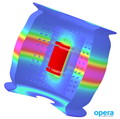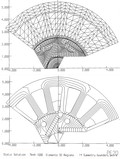text to clipboard
Electromagnetic design pioneers celebrate 30 years of success
from superconducting magnets for particle research to a spectrum of applications - the Opera software package marches on!
Oxford, UK, August 12, 2014 --- Coinciding with Cobham’s 80th anniversary celebrations, the developers of the renowned Opera electromagnetic simulation software are celebrating the 30th anniversary of the Vector Fields Software business unit. Initially focused on making the design of particle accelerator magnets practical, their software tools remain at the leading edge of electromagnetic design today. This success is in large part due to continuing development of the founders' pioneering ideas for numerical software - which made possible the first practical commercial solution for solving complex and three-dimensional electromagnetic simulations.
The first major users for Opera software were almost all at the major physics labs around the world. At these sites, Opera was used to prototype advanced superconducting and resistive magnets for high energy and particle physics research - equipment which was too large and costly to prototype and refine in the normal 'cut and try' way. This user base at the very forefront of global scientific knowledge still remains a major strand of the company's business. However, the functionality of Opera and the user-friendliness of the design tools, has evolved almost beyond recognition to offer solutions for a much broader range of design requirements.
Opera has a distinguished track record of technological firsts and pioneering advances in electromagnetic design. Although progress in computing and graphics technology have been of enormous importance and often appear to underpin advances in the field, the background work of Opera developers on fundamental mathematical techniques, on accurately modelling material properties, speeding design entry and analysis, and optimising designs, has resulted in orders of magnitude improvements in the speed and fidelity of the virtual prototyping process. Today, much of the company's research revolves around allowing the software to perform ever more complex multi-physics simulation of electromagnetic design problems - taking into account factors such as mechanical stress and temperature – and improving performance using parallel computing.
"When we started in business, speed of simulation was the most fundamental challenge we faced," says Chris Riley, who was the fifth employee to join the early start-up Vector Fields business. "Even though we now have orders of magnitude more computing power, execution speed is still a critical challenge - because the scale and complexity of design problems also continually expands. It doesn't matter if you're designing a multi-million dollar magnet system for steering particle beams, or a $20 electromechanical actuator - today's users want to squeeze the last fraction of a percent of perfection out of any idea. And that demands capabilities such as 3D modelling, finer resolution of finite element meshing, consideration of multi-physics effects and intelligent optimisation. The challenges keep on coming, and overcoming them to deliver software that can be used to perform optimal electromagnetic design is the driving force behind Opera today."
The technology behind Opera began life at the UK's Rutherford Appleton Laboratories (RAL) who cooperated with CERN in the 1970s to help break down a barrier as particle physics research moved towards higher energy accelerators - the need to reliably design superconducting magnets. After initial work on volume integral formulation software the team looked at solving Maxwell's equations using the more versatile finite element analysis technique. Chris Biddlecombe, now Opera Development Manager, created a program called PE2D (Poisson's Equation in Two Dimensions) using magnetic vector potential, which met with considerable success. However, making a direct transition to three-dimensional analysis would not have been viable with the computer resources available in the late 1970s. This led RAL scientists Bill Trowbridge and John Simkin - who went on to found Vector Fields in 1984 – to develop a new computational technique based on the use of scalar potentials. The commercial electromagnetic finite element 'solver' - named TOSCA for TOtal SCAlar - was a breakthrough and won its developers the Maxwell Premium Award from the UK's IEE. Its ideas still form the basis of much of the Opera suite of tools today.
The core electromagnetic simulation technology was in place. The focus of much of the early work for the fledgling Vector Fields business was the development of a graphical modelling and post-processing environment, and analysis functionality - to create a comprehensive suite of user-friendly tools for the virtual prototyping design process. This all came together by the late 1980s, and it was dubbed Opera. Vector Fields continued successfully developing more application specific tools and advanced analysis capabilities, often in collaboration with prestigious partners, from leading-edge industrials to educational leaders. Vector Fields now trades under the Cobham brand after joining the Cobham group in 2005, where it has continued to grow and maintain its place as one of the world leaders.
Today, thousands of users employ Opera for design and simulation tasks for applications such as electrical machines, transformers, X-ray tubes, ion beam sources, ship signature calculations and non-destructive test equipment. The company's recent annual European User Group Meeting saw presentations on applications as diverse as HEV traction motors to particle accelerators, magnetic gearing to aerospace components.
Recent advances include parallel-processing capability to match modern hardware, the first multi-language versions and enhancements to deliver true easy-to-use multi-physics models.
“In the ever-advancing world of virtual prototyping there is no such thing as resting on your laurels” says Kevin Ward, director of the Vector Fields Software business. “We have an exciting five-year plan ahead of us for Opera, launching into new applications, putting it in the hands of a new wave of engineers, and establishing the technology in emerging markets.”
ENDS
For more information please contact Amanda Machado at:
Cobham Technical Services, Vector Fields Software, Network House, Langford Locks, Kidlington, Oxford OX5 1GA, UK.
t: +44 (0)1865 370151; f: +44 (0)1865 370277
vectorfields.info@cobham.com; http://www.OperaFEA.com
About Cobham
Cobham specialises in meeting the demand for data, connectivity and bandwidth in defence, security and commercial environments. Offering a technically diverse and innovative range of technologies and services, the Group protects lives and livelihoods, responding to customer needs with agility that differentiates it. The most important thing we build is trust. Employing more than 10,000 people on five continents, the Group has customers and partners in over 100 countries.
About Cobham Technical Services
Cobham Technical Services produces the world's most advanced software for modelling and analysing electromagnetic equipment and effects. Its virtual prototyping tools speed the design process - helping to achieve a user's goal, whether that is lowest cost, optimum performance, ease of manufacture, or the best combination.








 |
|